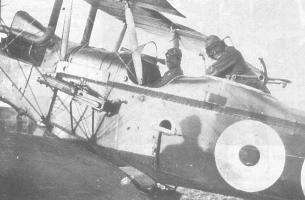ROYAL AIRCRAFT FACTORY R.E.8, Part III

One of the best known R.E.8 crews, from 69 Sqdn, RAFC: Lt. RC Armstrong
and Lt. FJ Mart (observer) in front of their machine. On June 9th, 1918
they forced a Halberstadt C1.II two-seated to lan in Allied territory, to
be captured intact by Australian troops. Note underwing racks with Cooper
bombs.
The "Harry Tate" People
Alberto Casirati
via Verdi 12
24052 Azzano S Paolo BG
Italy
As an ideal complement to the previous articles on the R.E.8 (published in WWI AERO #127 and
136), this mainly pictorial piece deals with two very different aspects of the machine's history: its
construction and the people who flew it into battle.
So different as they are, yet they were intimately connected, as the machine's typical features and
qualities had an immediate influence on the way in which it was employed by its crews.
In many ways, the R.E.8 was an innovative machine. Its bent main fuselage longerons and the
inclined position in which the engine was fixed to the airframe were studied in order to give the
machine shorter take-off and landing runs, while the narrow tail fuselage section was conceived to
reduce the rear gunner's blind spot to a minimum. What the R.E.8 lacked in engine horsepower it
obtained in terms of rugged construction, the well-known criticism (a dangerous machine to fly
because of a weak structure) being totally unjustified, since so many badly shot-up machines were
able to testify bringing
their crews home anyway.
Although the great bulk of glamour is still on the side of the fighter planes and pilots, there are
few doubts that the reconnaissance units had to do the most Important and dangerous job. R.E.8
crews did that constantly, with skill and determination. Thanks to their efforts, Army commands
got the vital information they needed for the safety of many, often at the price of the life of a
pilot- or, more probably, of an observer. This article shows some of those people, who played
such a humble yet vital role.

The same team aboard one of the 79 Sqdn's machines. Note absence of the
observer's Lewis gun.
Acknowledgment
Our most sincere thanks to Mrs Juanita Franzi, for the excellent drawings which illustrate this
short piece. The R.E.8 is not a very complex machine, but until now the details were not so easy
to appreciate, because of lack of suitable pictures or drawings. Thanks to Mrs Franzi's skill and
generous assistance, we are now able to provide a long overdue coverage of almost all of the
R.E.8 main technical features. Her drawings are the result of careful research work, and are traced
on the base of reliable contemporary references our grateful thanks to Colin A Owers, too,
without whose generous help we wouldn't be able to publish the interesting pictures which
illustrate the article.

The observers cockpit. Note locations of the Wireless Transmitter and
its aerial. Glass plates for the camera were stored above it. Also visible
is the emergency throttle for the observer.
Note: Due to the differences between printed matter and HTML format,
not all pictures and graphics of the article are shown.
Return To World War 1 Aeroplanes Inc.
© The Aviation History On-Line Museum.
2004 All rights reserved.


